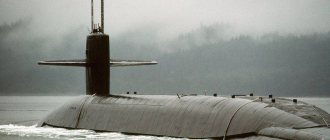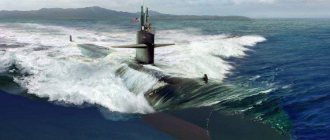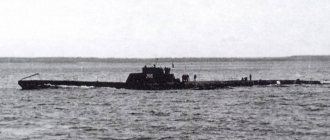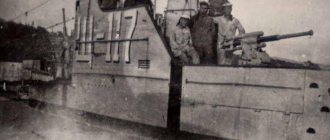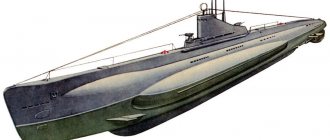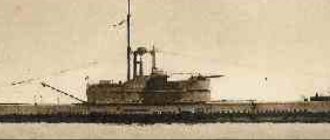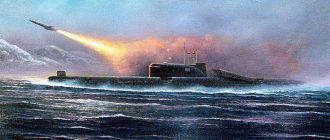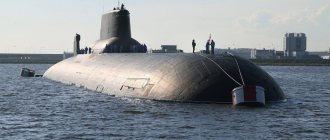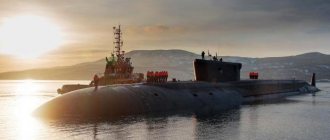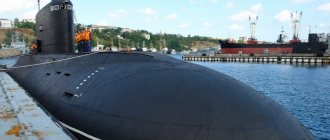4 338
In mid-1944, the fleet of Nazi Germany (Kriegsmarine) was replenished with an ultra-modern submarine type XXI. The Commander-in-Chief of the Kriegsmarine, Grand Admiral Karl DÖNITZ, intended to use it to once again turn the page in submarine warfare.
Part of the crew of the Type XXI submarine on deck in the Flensburg fjord. Mürvik Naval School is in the background.
The first real submarine
In the early years of World War II, the classic German submarine attack tactics looked like this.
After detecting the enemy, ideally at night, the submarine on the surface tried to take a convenient position for a shot and, remaining above the water, launched a torpedo. Then the boat quickly dived and underwater tried to get as far away from the enemy as possible before the escort ships launched a counterattack. The big problem with the submarines operating at that time was that they were in fact only diving submarines, and not in the full sense of the word submarines.
Attack of the German submarine of the English transport
The attack by the first truly submarine in naval history looked different. Once its radio or acoustic equipment detected a target, the Type XXI submarine, submerged, at high speed and on an intersecting course, sought to reach it. High accuracy of direction finding and target tracking, thanks to sonar and listening to noise, made it possible to reach the opening fire position without using a periscope.
The firing data was calculated by the electromechanical fire control unit on board. After an underwater attack using a periscope, the submarine went into the depths at high speed. According to German historians, Type XXI submarines avoided attacks from escort ships without any problems, because the pursuers' sonar operated at speeds of 12-13 knots. The boat itself could move underwater at a speed of about 16.5 knots.
Achievements of the Navy
The Kriegsmarine inflicted considerable damage on its opponents throughout the war. For example, the most effective captain Otto Kretschmer sank almost fifty enemy ships. There are also record holders among ships. For example, the German submarine U-48 sank 52 ships.
Throughout World War II, the German navy managed to destroy 63 destroyers, 9 cruisers, 7 aircraft carriers and even 2 battleships. The largest and most notable victory for the German army among them can be considered the sinking of the battleship Royal Oak, whose crew consisted of a thousand people and its displacement was 31,200 tons.
Type XXI submarine – high combat effectiveness
As soon as the first combat-ready submarines entered the Kriegsmarine in mid-1944, the operational command of the submarine fleet tried to determine the operational principles for the combat use of the new ships. In this regard, on July 10, 1944, a memorandum “Considerations for the combat use of Type XXI” was issued.
In addition to the advantages of the new type of submarine, it reflected the high level of disappointment with the general course of submarine warfare, as well as the features of the successful Allied anti-submarine defense:
«The Type XXI is a boat with strong undersea combat capabilities that are suited to largely overcome allied anti-submarine defense superiority due to its air and surface dominance. With this boat it will be possible to start a successful submarine war (...). «
Functional diagram pl XXI
On the contrary, judgments regarding the survivability of the new submarine, which was understood as the ability to withstand an enemy attack, are less euphoric. In particular, it is realized that the detected submarine will not be able to approach the enemy within torpedo attack range without the risk of its own sinking.
Consequently, it was necessary to enter a firing position above or under water unnoticed. In general, there was a principle for submarine commanders: to remain as unnoticed as possible in the operational area. But the Type XXI sneaking submarines offered entirely new tactical options. According to experts, they were the result of outstanding underwater performance.
Attack of a German submarine by Canadian bombers in the North Atlantic
New war strategy
The memorandum did not discourage the successful “swarm” tactics that characterized the first phase of submarine warfare in the Atlantic from mid-1940:
«... since it is advisable to concentrate one's forces against the united defense.»
At the same time, the combat effectiveness of a single Type XXI boat was rated higher than that of ships built earlier. It was believed that, once in an attacking position, the team, thanks to the rapid reloading of torpedo tubes, was capable of firing up to 18 torpedoes in three salvoes. This seemed to be a hitherto unimaginable increase in combat power.
The memorandum already quoted states:
«The introduction of several Type XXI submarines is already leading to a much greater fragmentation of defenses than the significantly larger number of previous warships. Principle: The combat use of a boat is expensive, so the first attack must lead to a worthwhile success. This is especially true in operations in so-called transport craters close to the coast. .«
Boat U 3505 goes on a training trip. The submarine was accepted into the fleet on October 7, 1944. Sunk by Allied aircraft on April 3, 1945.
The command of the Third Reich Navy was able to fully use the combat qualities of the new ship when the boat was used for combat operations at a great distance. This is stated in the quoted memorandum dated July 10, 1944:
“The enemy’s air superiority in all sea areas forces boats of previous types to make passages under water and far in the free Atlantic, for which they are not designed by their design. This circumstance, primarily due to the ever-increasing overload of the cabin with anti-aircraft guns and radars, is becoming more and more inappropriate. In May 1942, the IX-C took 50 days to sail to the Caribbean. On the contrary, for type XXI the calculation was 28 days. A Type XXI boat practically goes almost twice as fast as a Type IX C boat."
Tactical Advantages
If necessary, a Type XXI submarine could make a long journey under water. Of course, not an electric motor and batteries were used for this, but diesel engines. Moreover, their air supply was guaranteed by an innovative system for operating the engine under water - a snorkel. In this case, only the rubber-coated snorkel head protruded above the sea surface. The likelihood of its detection by Allied radars was extremely low, and only short water eddies could be detected visually above the water.
Pl U2513 in the open sea. The raised snorkel device is clearly visible
The tactical advantage of reducing the time of arrival in the operational area is obvious: there is more time for actual combat use. In addition, the need for dangerous, but necessary for other submarines, fuel supplies at sea was eliminated.
The Kriegsmarine command in mid-1944 assigned the Type XXI a maximum diving depth of about 300 m. In terms of depth, the boat's characteristics ensured defensive stability in case the enemy pursued it with depth charges. However, in practice, the operating depth of the new type of boat was not maintained. Only after strengthening the structure during test dives was it possible to reach a maximum of 220 m.
The speed of the Type XXI submarine for evading enemy submarine hunters is interesting. With electric motors it reached 16.5 knots (30.6 km/h). When sneaking, as a rule, it was six knots (11.3 km/h), and during an underwater passage on diesel engines with a snorkel - 10.42 knots (19.3 km/h).
Engine (diesel) compartment pl type XXI. Museum "Wilhelm Bauer".
Equipment and service
Innovative for that time, acoustic and echo-sounding equipment allowed the Type XXI crew to better control the behavior of enemy anti-submarine forces. In particular, while remaining underwater, the boat could avoid enemy location signals (ASDIC), the propagation range of which reached 5 km.
For radio communications, the Type XXI was equipped with the most modern communications equipment of its time. The boats sent their reports to the operations center on land using short waves. Reception of orders was carried out on short, long or ultra-long waves.
For single use in large sea areas, Type XXI submarines offered previously incredible amenities for 57 crew members: larger quarters, more berths, and air-conditioned temperatures.
Captain's cabin. Museum "Wilhelm Bauer".
Non-commissioned officers' cabin pl. XXI. Museum "Wilhelm Bauer".
In addition, there was a sufficient amount of equipment for provisions, which were stored in large refrigeration units, as well as improved ventilation of the premises during underwater passages. These factors led to a decrease in the physical and mental stress of the crew.
Another achievement of the new submarines was the presence on board of two sump pumps at the bow and stern. Pumps provided drainage of water penetrating at great depths. The installation of these units made it easier to equalize the amount of water in the boat, which was tedious for the central post.
Galley pl. XXI. Museum "Wilhelm Bauer".
Kriegsmarine performance results
German submarines of the Second World War, photos of which can often be found in books about military equipment, played a very important role in the offensive of the Third Reich. Their power cannot be underestimated, but it is worth considering that even with such patronage from the bloodiest Fuhrer in world history, the German fleet did not manage to bring its power closer to victory. Probably, good equipment and a strong army were not enough; for Germany’s victory, the ingenuity and courage that the brave soldiers of the Soviet Union possessed was not enough. Everyone knows that the Nazis were incredibly bloodthirsty and did not disdain much on their way, but neither an incredibly equipped army nor a lack of principles helped them. Armored vehicles, a huge amount of ammunition and the latest developments did not bring the expected results to the Third Reich.
From sunrise to sunset
The basic idea for the Type XXI arose when, in 1940, a completely new type of propulsion for submarines became apparent. According to experts, then the serial construction of Type XXVI submarines with an air-independent “Walter-Antrieb” engine became a big leap in underwater technology. However, the turbine submarine, where T-fuel (“Aurol”) interacted with a catalyst (C-fuel) to produce a high-temperature oxygen-steam mixture (“steam gas”) to rotate the turbine, did not achieve the requirements corresponding to combat use.
Initially, it was planned to install a “Walter engine” on boats of type XXI. Subsequently, the space planned for this in the new submarine project was filled with new, especially lightweight batteries. The result was the “large electric” submarine Type XXI and its smaller, designed for use in coastal waters and marginal seas, the Type XXIII.
Battery for electric motor pl type XXI. Museum "Wilhelm Bauer".
From section to ship
Construction of the new Type XXI submarine on an industrial scale began in wartime 1944. After the sectional construction method was implemented, despite the doubts of the shipyards involved.
In the longitudinal direction, the structure of the new ship was divided into eight sections. Each section was built complete with all equipment and wiring in each case in its own production center. The finished sections were transported by road or inland waterway to assembly yards. There they were connected into larger units and the construction of the boat was completed.
Transportation of section of submarine type XXI by waterways
This time-based construction method, borrowed from the automobile industry, was not accepted by shipyards. Shipbuilders preferred to work on the submarine as a whole. But the planned release of two or three submarines per day convinced those in charge - at least on paper.
However, the construction of more than 1,300 boats envisaged by the program was never realized. Allied bombing of the sections' shipyards and production sites significantly affected the overall result.
Plan Z
Since Hitler considered his fleet extremely important for Germany’s triumph over other countries and had extremely positive feelings towards it, he paid considerable attention to it and did not limit funding. In 1939, a plan was developed for the development of the Kriegsmarine for the next 10 years, which, fortunately, never came to fruition. According to this plan, several hundred more of the most powerful battleships, cruisers and submarines were to be built.
Difficult start
The first Type XXI submarine, hull number U 2501, was accepted into the Kriegsmarine on June 27, 1944 as a test boat. At the same time, back in 1944, engineers designed two more variants of type XXI (“B” and “C”). They differed from the main one mainly in the number and location of underwater weapons. But, like many weapons projects of the Third Reich, they also did not go beyond the planning phase.
Nose compartment. Four torpedo tubes are visible. Museum "Wilhelm Bauer".
Between 27 June 1944 and the end of the war in May 1945, Hitler's fleet operated a total of 118 Type XXI submarines. Other copies in May 1945 - in an advanced stage of production. In addition, Allied bombers destroyed the submarines during the assembly phase.
Operations Regenbogen and Deadlight
Legends about the fate of hundreds of German submarines continue to circulate today. In myths and free interpretations, they exported the Nazi leadership to South America, and from it - minerals, as if repeating the policy of the conquistadors. In reports of varying degrees of reliability, submarines of the Third Reich continue to be found sunk in Antarctica, Taimyr and off the coast of Crimea.
In fact, the fate of Hitler's submarine fleet was the same as that of the rest of the army - it was defeated. Most of the boats were lost in battle; the remaining ones were subjected to two interesting operations. The first is called “Regenbogen”. It is no coincidence that this word sounds so German - the operation was planned and implemented by the Nazis themselves. At the end of April 1945, an imminent surrender became obvious, and Doenitz ordered the crews of all German ships to scuttle them to preserve the honor of the fleet. The order was carried out - 238 submarines went to the bottom. By the way, Regenbogen is translated from German as “rainbow”.
The Allies also did not spare Hitler’s captured submarines. At the end of 1945 - beginning of 1946, they carried out Operation Deadlight, during which 121 captured submarines were sunk. Another 33 submarines remained with the victorious countries for testing, replenishing their own fleet and creating museums.
Karl Doenitz survived the Nuremberg trials, served 10 years and died in 1980. He spent the rest of his life in obscurity, but wrote three books - two about his life and one about submarine warfare tactics.
